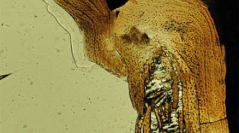

 Comptes Rendus Palevol
10 (5-6) - Pages 367-380
Comptes Rendus Palevol
10 (5-6) - Pages 367-380The Upper Barremian (Lower Cretaceous) site of Las Hoyas (Spain) is an important Konservat Lagerstätte that has a yielded well-preserved biota. Both the palaeohistology and the preservation of six tetrapods were investigated in this study. Chemical analysis (Ca/P ratio, fluorine, strontium, barium and REE amounts) reveals an alteration of the original apatite of the bone in fluoroapatite by postmortem substitutions, a late Sr incorporation during fossilization, and a rather moderate postmortem REE incorporation in the freshwater environment of Las Hoyas. However, the conditions of fossilization have limited the dissolution-recrystallisation processes and preserved the microstructure of the bones. Bone growth rate estimations have been made according to Amprino's rule. The Discoglossidae indet, the Centrocryptodira indet. and Scandensia ciervensis are characterized by low growth rates and an ectothermic metabolism. Concornis lacustris , Pelecanimimus polyodon and the Archosauria indet. are characterized by a faster growth and probably higher resting metabolic rate. All of the specimens are adults of small-sized species. This leads to the hypothesis of an ecological filter favoring small-sized species in this ecosystem, strengthening the taphonomical results. The combination of geochemical and histological studies seems to offer a more precise overlook of life history traits and preservation of these fossils from Las Hoyas.
Palaeohistology, Growth rate, Preservation, Diagenesis, Tetrapods, Las Hoyas, Cretaceous